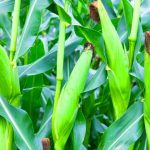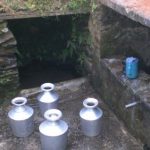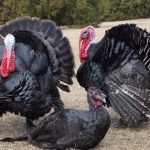Groundnut Farming Introduction, Management

Introduction:
Also known as peanut, earthnut, monkey nut, goober and Manilla nut, groundnut is primarily used in the manufacture of vegetable oil (Vanaspati ghee). Its seed contains about 45% oil and 26% protein. Groundnuts are a good source of all B vitamins except B12.The biological value of groundnut protein is among the highest of the vegetable proteins, and equals that of casein. With regards to minerals, phosphorus, calcium and iron are present in significant amounts.
Origin and history:
It appears to have evolved in Brazil in South America. In 1838, Bentham published his ‘Flora Braziliensis’ describing five species of Archis, all from Brazil.
Area and distribution:
Groundnut is grown on a large scale in almost all the tropical and subtropical countries of the world. The most important groundnut growing countries are India, Nigeria, Sudan, and the USA. It is grown over an area of 24.7 million hectares with a total production of 33 million tonnes in the whole world.
Botanical description:
The groundnut belongs to the Leguminoseae family. It is an annual, and the plants grow from 30-60 cm high and produce angular, hairy stems with spreading or erect branches. It has a relatively deep tap root system with a well developed lateral root system.
Leaves of groundnut are usually pinnate with 2 pairs of ovate leaflets. The leaflets are arranged opposite to each other impairs. The leaves occur alternately, one at each node.
The flowers are borne at the axis of the leaves, either above or below the ground. The flowers have yellow petals. Eight to ten stamens form a monoadelphous bundle. Generally flowers are self-pollinated. The fruit is an indehiscent pod containing one to five seeds.
Climatic Requirements:
It is essentially a tropical plant. It requires a long and warm growing season. The most favourable climatic conditions for groundnut are a well distributed rainfall of at least 50cm during growing season, abundance of sunshine and relatively warm temperatures. It seems that the plant will grow best when the mean temperature is from 21-26.5 degree Celsius.
Soil:
Groundnut thrives best in well-drained sandy and sandy loam soils. Clay or heavy soils are not suitable for this crop. Groundnut gives good yields in the soil with pH between 6.0-6.5.
Cropping systems:
Groundnut is grown in rotation with wheat, lentil, chick pea, barley, etc. It is grown as a mixed crop with pearl millet maize, sorghum, castor and cotton. The most common cropping systems are as below:
- Groundnut-wheat
- Groundnut-barley
- Groundnut-chickpea
- Groundnut-field pea
- Groundnut-lentil
Field preparation:
Although groundnut is a deep rooted crop, looking at its underground pod forming habit, deep ploughing should be avoided. One ploughing with soil turning plough followed by 2 harrowing would be sufficient to achieve a good surface tilth up to 12-18cm depth.
Seed and sowing :
Selection and treatment of seed:
Pods for seed purposes should be stored unshelled in a cool, dry and ventilated place. For seed purpose, pods should be shelled by hand one week before sowing. Only bold seeds should be used for sowing. Treat the selected kernels with 5g of Thiram or Captan or Ceresan per g of kernels so as to check various seed and soil borne diseases.
Time of sowing:
Where irrigation facilities are available, sow groundnut around 20th June or 10-12 days before the onset of monsoon with a pre-sowing irrigation. Sow the rain fed crop with the advent of monsoon in the last week of June or in the first week of July.
Spacing, seed rate and method of sowing:
The row to row distance is kept at 30-40 cm and 45-60cm under bunch types and in spread types respectively. 80-100 kg of seeds per hectare would be enough for bunch types and 60-80 kg for spreading types. Plant to plant distance would be 15 and 20cm for bunch and spreading types respectively. Sowing should be done about 5cm deep behind the plough or with the help of a dibbler or seed planter.
Manures and fertilizers:
Through nitrogen fixation, groundnut takes major part of its nitrogen. However, an application of 20-40kg nitrogen per hectare as a starter dose is given to meet the nitrogen requirements of the crop in the initial stage in poorly fertile soil. 10-15 tonnes FYM maybe added per hectare about 15-20 days before sowing. Phosphorus should also be applied preferably through superphosphate and potassium should also be supplied depending on soil (after soil test). Calcium also has good effect on proper development of pods and kernels. Apply gypsum at the rate of 125 kg per hectare.
Water management:
Groundnut doesn’t need irrigation as it is a rainy season crop. In extreme conditions, irrigation may become necessary. The field should be well drained.
Weed control and earthing:
Normally, one or two hand hoeing and weeding should be done, depending upon soil type and extent of weed infestation. Also be done by the application of nitrogen (TOK-E-25) at the rate of 4 litres dissolved in 600 litres of water as pre-emergence spray.
The earthing up should be taken up simultaneously with intercultural operations.
Diseases:
- Tikka: This disease is caused by two species of fungus, Cercospora; i.e., C.personata and C.arachidicola. Small dark brown circular spots appear on the leaves. When the attack is severe, defoliation occurs and only the stem remains.
Control measures: Treat the seed with Thiram at the rate of 5g per kg of seed. Collect the infected plant debris and burn them. Grow some tolerant varieties like T-64, C-501, MH-4, TMV-6 and TMV -10. - Rosette: This disease is caused due by the virus transmitted through aphids. Plants when infected by it looks stunted and have bushy appearances.
Control measures: Rouge out the infected plant as soon as they appear in the field. To check the spread of the disease, aphids should be killed by giving a spray of Oxydemeton methyl 25EC at the rate of 1 litre dissolved in 1000 litres of water per hectare.
Other diseases include: Charcoal rot, rust, Sclerotium rot , seed and pre emergence rot, etc.

 दिल्लीको होटलमा बसेर क्यानडा र अमेरिकामा मानव तस्करी
दिल्लीको होटलमा बसेर क्यानडा र अमेरिकामा मानव तस्करी  अनलाइन जुवा खेलाएर काभ्रेका अनिलले गरे दुई अर्बको कारोबार
अनलाइन जुवा खेलाएर काभ्रेका अनिलले गरे दुई अर्बको कारोबार  मुख्यमन्त्री सोडारीले विश्वासको मत लिन सुदूरपश्चिमको प्रदेश सभा बैठक आव्हान
मुख्यमन्त्री सोडारीले विश्वासको मत लिन सुदूरपश्चिमको प्रदेश सभा बैठक आव्हान  अफगानिस्तानमा बाढीबाट ३१५ भन्दा बढीको मृत्यु
अफगानिस्तानमा बाढीबाट ३१५ भन्दा बढीको मृत्यु  सुँगुरको मिर्गौला प्रत्यारोपण गरिएका रिचर्डको निधन
सुँगुरको मिर्गौला प्रत्यारोपण गरिएका रिचर्डको निधन 


